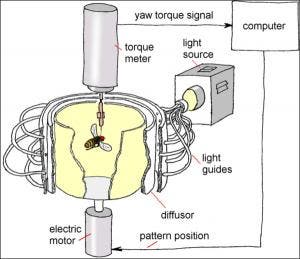We could go on about what free will is until dusk and still not reach a conclusion. Indeed, philosophers have been theorizing free will for thousands of years, but haven’t we neglected an important aspect? There seems to be a general consensus that free will is entirely a human trait, but what of other animals? An older study, published in a 2007 edition of PLoS ONE, showed that free will and true spontaneity exist … in fruit flies.
The common fruit fly is easy to care for, breeds quickly, and lays many eggs, which is why it has been used for decades in biological research, especially genetics. Actually it was one of the first organisms to be used in genetic research, and a number of advances, especially basic principles of heredity, have been proven and documented with the help of this insect.
Are animals, insects as well, simple robot-like minded organisms that merely respond to external stimuli and thus lack even the smallest hints of free will? This used to be the general understanding, among scientists at least, and when animals were observed behaving differently than expected, even to the same external stimuli, this variability was attributed to random errors in a complex brain.
An international team of scientists, however, proved that this kind of variability in behavior cannot be due to simple random events but is generated spontaneously and non-randomly by the brain.

The fly’s tendency to perform left or right turns (yaw torque) is measured continuously and fed into the computer. In closed-loop, the computer controls arena rotation (single stripe or uniform texture as patterns on the arena wall). An additional white screen (not shown) covered the arena from above for all groups. (c) Maye A, Hsieh C-h, Sugihara G, Brembs B (2007)
The scientists placed fruit flies in an environment where its surroundings were of completely uniform white, and recorded their turning behavior. No external stimuli whatsoever was introduced in the chamber – no light, no sound, no vibrations, nothing. Lacking absolutely no input, the fruit flies movement in the chamber should have resembled a random pattern, like the noise the radio makes when its tuned between stations. Using a combination of automated behavior recording and sophisticated mathematical analyses, the scientists found that the structure of the fly’s behavior was very much different from what one would call noise. A myriad of complex random computer models were introduced, but none could adequately model the fruit flies behavior.
“I would have never guessed that simple flies who otherwise keep bouncing off the same window have the capacity for nonrandom spontaneity if given the chance,” said Alexander Maye from the University of Hamburg, lead author of the 2007 paper.
“We found that there must be an evolved function in the fly brain which leads to spontaneous variations in fly behavior” co-author George Sugihara said. “The results of our analysis indicate a mechanism which might be common to many other animals and could form the biological foundation for what we experience as free will”.
What is free will?
Just recently, another research team, this time from Harvard University, assembled a new experiment to test the fruit fly’s free will. The scientists used isogenic fruit flies – genetically similar from inbreeding, but not identical – which they introduced in a contraption they appropriately name the “FlyVac”. You’ll see why.
The device which the Harvard researchers employed has a T-shaped maze, like a fork in the road, with LEDs at each of the two ends. The end of the fork to be illuminated was chosen on random, and as the fruit fly entered the maze, it had to make a phototactic choice: either it went towards the light making the decision photopositive or move away from it, in which case the decision was photonegative. No matter its predispositions towards light, photons and such, the fly was vacuumed away from the maze rather unceremoniously, and taken back to its initial position. It then started all over again, and again, and again. I didn’t understand from the paper how many times per fly they did this, by I presume a lot – for 17,600 flies!
I bet your curious to find out what they got. Well, for instance one photopositive fruit fly strain chose light about 80% of the time. However, one oddball fly in this group chose light 100% of the time. When verifying other fruit fly strains involved in the experiment, similar results were found. The variability encountered was much grater than that possibly occurring from chance alone. The results were published in the journal PNAS.
“The question of whether or not we have free will appears to be posed the wrong way,” says Brembs. “Instead, if we ask ‘how close to free will are we”‘ one finds that this is precisely where humans and animals differ”.










